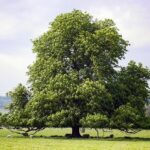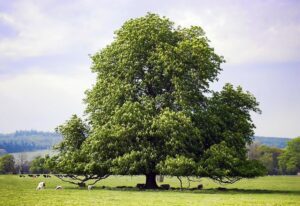
By John Dieckmann
Prior to 1900, an estimated three billion American chestnut trees populated the Eastern United States. It was an important tree ecologically, with its nuts being an vital food source for a variety of wildlife and a significant food source for people. Chestnut wood was used in both construction and in furniture making.
In the late 19th century, a blight fungus that attacks chestnuts was inadvertently imported from Asia. The fungus spores spread rapidly, and by 1925, the vast majority of American chestnut trees had been infected and killed.
In the 1970s, the American Chestnut Foundation was organized to restore the American chestnut. Since the Chinese variant of the chestnut is blight resistant, the idea was that by carefully crossbreeding the two chestnut varieties, the American chestnut could acquire the blight resistance of the Chinese chestnut while maintaining the unique characteristics of the American variety. This is a lengthy process, as each generation of new chestnuts takes several years to mature to the point where it can produce seeds (the nuts). Now, blight-resistant varieties have been produced in quantity. However, the trees are not immune to the blight.
Genetic engineering technology is now being used to make American chestnuts truly blight resistant. The cause of the chestnut die-off is that the blight fungus produces oxalic acid, which destroys the cambium, the living layer under the bark where sap flows. Oxalate oxidase (OxO) is a naturally occurring enzyme that breaks down oxalic acid. Genetic engineering has been used to take a gene from wheat for producing OxO and inserting it into the American chestnut genome.
The resulting chestnuts retain all of the characteristics of the American chestnut, with durable blight resistance based on OxO breaking down the oxalic acid before it can damage the cambium layer.
For several years now, this modified chestnut has been going through an extensive regulatory review that applies to all genetically modified organisms to approve its widespread use. All signs point to this chestnut being approved soon, at which point it can be reintroduced into the wild. Visit the American Chestnut Foundation website (www.acf.org) for more information about the process.
John Dieckmann is a director of the Belmont Citizens Forum.



Sorry, the comment form is closed at this time.